“All good revolutions begin like this.”
Prince Zeid Ra’ad Al Hussein, CEO of the International Peace Institute, 2022 Design for Freedom Summit
When Prince Al Hussein made this remark during last year’s inaugural Design for Freedom Summit, it was more than a memorable tagline, it was an insightful way to frame an ambitious movement to remove forced labor from the built environment. As we approach our second annual Design for Freedom Summit on March 30, convening the most innovative industry leaders across sectors, it’s worth looking back to see how far the movement has come and how a revolution can start with just one voice.
On Thursday, March 30, hundreds of forward-thinking industry leaders representing the full ecosystem of the built environment, will gather for our second annual Design for Freedom Summit. More than 40 industry leaders and experts will be speaking at this year’s Summit. For more information about speakers, the agenda, travel, and registration, click here.
The revolution began with a question
In 2017, Sharon Prince, CEO and Founder of Grace Farms Foundation, asked a question while she was on an AIA (American Institute of Architects) National Jury panel, which was assessing several new architectural projects, including one in a forced labor hot spot. “When I asked if the bricks used in [this project] in a hotspot area were made without forced or child labor, that question was met with silence,” Prince said in an interview with Madame Architect.
It was a moment that stayed with Prince. “Once you know, you can’t unknow it and from that point I had a laser focus to bring together leaders within the ecosystem of the built environment who can influence and shift the material supply chain towards ethical sourcing.”
“Once you know, you can’t unknow it.” – Sharon Prince
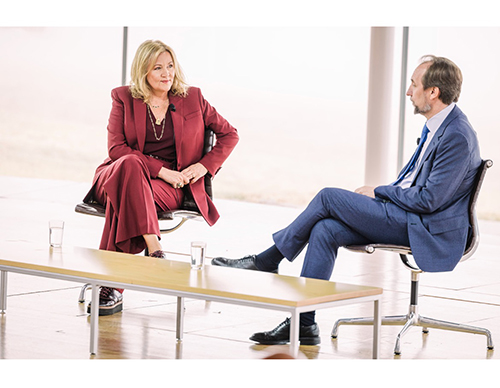
From left to right: Sharon Prince, CEO and Founder of Grace Farms Foundation and Prince Zeid Ra’ad Al Hussein, CEO of the International Peace Institute, at the 2022 Design for Freedom Summit.
The Launch of the Movement
That same year, Prince met the late Bill Menking, Founding Editor-in-Chief of The Architect’s Newspaper, at Grace Farms to discuss why forced labor was not on the industry’s agenda and what could be done to put it on the agenda. Unlike many revolutions, which often begin from the ground up, Prince knew a “top-down” approach was the only way to address and dismantle the industry-wide use of forced labor. To take actionable steps toward addressing this humanitarian crisis, Prince launched the Design for Freedom Working Group. Since its launch, there are now more than 100 industry leaders and experts committed to the Work Group, as well as a Design for Freedom Working Group contingent in London.
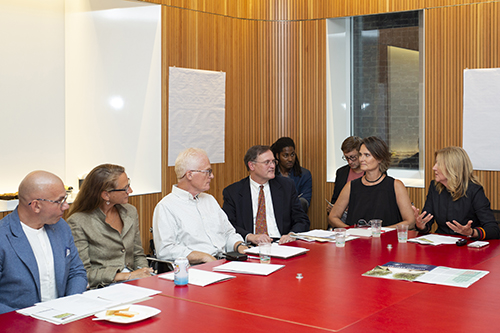
Sharon Prince, far right, presides over a Design for Freedom Working Group meeting in New York City. Photo by Niv Rozenberg
Scope of the Problem
On any given day, there are nearly 28 million people – men, women, and children – in forced labor, according to the latest statistics from the International Labour Organization (ILO). [1]
The number of people held in forced labor has increased over that past five years, from 25 million in 2016. “It is shocking that the situation of modern slavery is not improving. Nothing can justify the persistence of this fundamental abuse of human rights,” said ILO Director-General, Guy Ryder. “We know what needs to be done, and we know it can be done. Effective national policies and regulation are fundamental. But governments cannot do this alone. International standards provide a sound basis, and an all-hands-on-deck approach is needed. Trade unions, employers’ organizations, civil society and ordinary people all have critical roles to play.”
Most cases of forced labor, 86 percent, are found in the private sector. The $12 trillion construction industry is the number one industrial sector at risk of forced labor, according to the ILO, accounting for more than 13% of global GDP.[2]
- Of the 27.6 million people in forced labour, 17.3 million are exploited in the private sector
- 12% of all those in forced labour are children.
- The Asia and the Pacific region has the highest number of people in forced labour (15.1 million) [1]
Accelerating the Movement
To raise awareness and accelerate the movement, Prince and her team have made more than 100 presentations to professionals, students, and to the public, locally and globally since 2019. More than an estimated 800 AEC, business, sustainability, and law students have joined the movement through presentations given to universities.
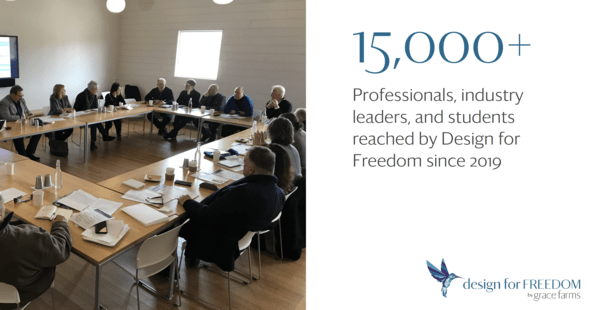
In October 2020, Grace Farms published the comprehensive and groundbreaking Design for Freedom report, featuring commentary and analysis from over 30 industry leaders and exports across the ecosystem of the built environment. By this time, Prince had convened more than 80 leaders to join the Design for Freedom movement. To compliment the Design for Freedom report, the Design for Freedom ToolKit was published in 2022 to provide practitioners with the tools and a blueprint to implement supply-chain auditing standards and strategies to work with suppliers along the supply chain. To date, more than 933 professionals have downloaded the toolkit to help with material sourcing strategies.
“Almost all modern construction projects around the world are subsidized with slavery, due to unchecked forced labor that permeates thousands of raw and composite materials sourced locally to globally. Once you know, you cannot unknow it.” – Sharon Prince, Design for Freedom report
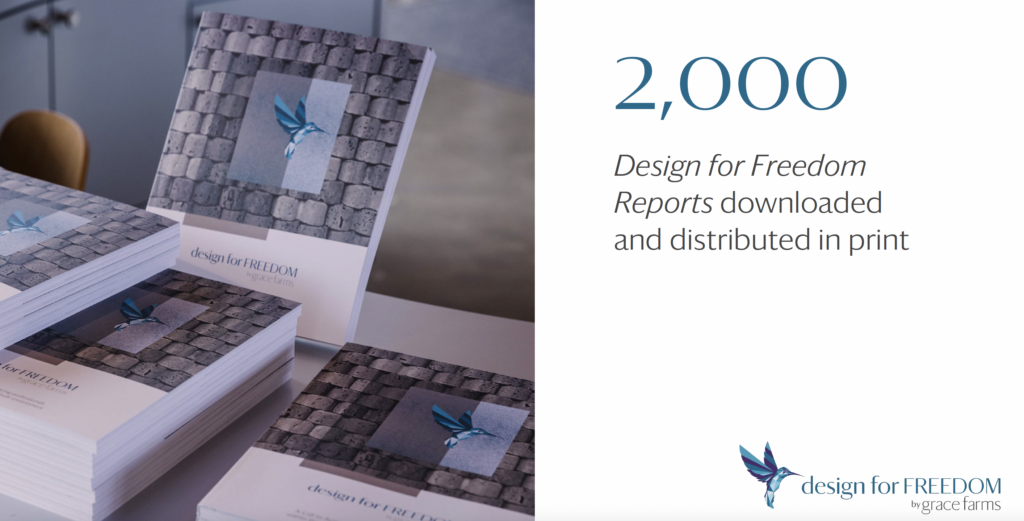
Grace Farms Foods Demonstrate Design for Freedom Principals
Bringing people together over shared meals has been central to our journey, from currently donating more than 200 wholesome meals per week to our not-for-profit partners to demonstrating our commitment to ethical and sustainable food.
We opened Grace Farms with River Roast, a perfectly balanced blended coffee sourced exclusively from women-led co-ops in Ethiopia, Colombia, and Indonesia. In 2021, Grace Farms Foods was launched, and maintained this commitment to ethical and sustainable coffee and tea, and transparent supply chains. Its mission is to support Design for Freedom and to make the world a more just, sustainable, and peaceful place. In 2022, Grace Farms Foods received its Certified B Corp status, in recognition of their leadership in the global movement for an inclusive, equitable, and regenerative economy.
Grace Farms Foods is the first U.S.-based organization to partner with Fairtrade International, a global leader in assuring all producers adhere to rigorous ethical and sustainable sourcing and production standards. During the Summit, participants will have an opportunity learn more about our commitment to ESG and ethical sourcing, as well as enjoy a variety of Grace Farms Foods teas and coffee, as well as Tony’s Chocolonely, whose chocolate is 100% slave free.
Throughout the year, we educate the public about ethical and sustainable practices, including professionals, students, and the community, through our tours and educational programs about Design for Freedom. In addition, visitors can participate in our interactive pop-up talks that take place throughout the day. Designed for all ages, they explore topics including sustainable design, food equity, and ethical supply chains. Visit the Welcome Center to learn about which talks will be offered on the day of your visit.
To learn more about our commitment to using ethical and sustainable supply chains, proving transformational work can be done to create a future free of forced labor, this recent Forbes article featuring Co-Founder of Grace Farms Food, Adam Thatcher, explains how this “coffee and tea company is forging a new kind of social entrepreneurship.”
“Sharon Prince is one of those rare leaders who is always open to new ideas and seeing how far we can take things.” – Adam Thatcher, Co-Founder of Grace Farms Foods
Media Helps Accelerate the Movement
“With her Design for Freedom effort, Sharon Prince is working to get leaders in architecture and construction to find ways around using materials made with slave labor.” – Fast Company
Publications including Fast Company, The Architect’s Newspaper, Madame Architect, Vogue Greece, The Architectural Record, and others began to report on Design for Freedom movement. In August 2022, Fast Company recognized Prince as among the most creative people in business in 2022, joining 56 innovators across sectors.
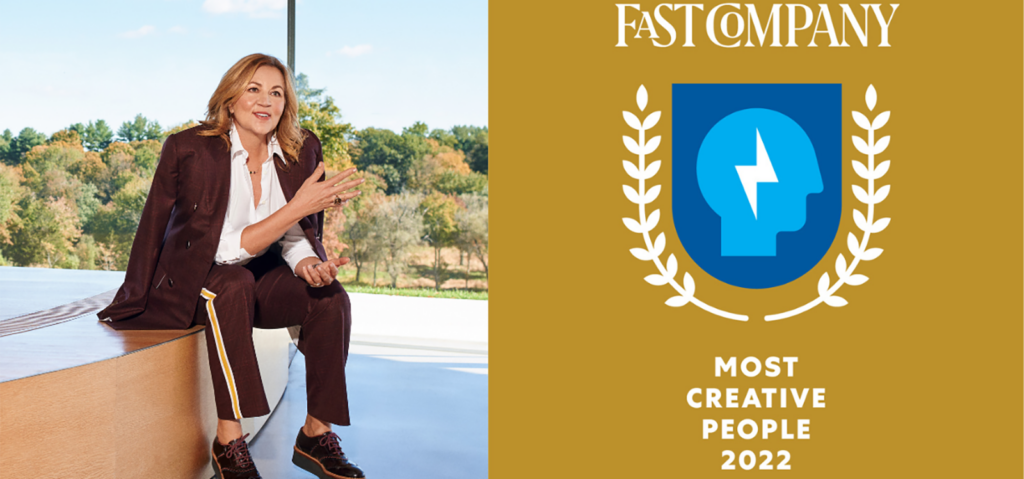
In addition to Fast Company‘s recognition, the CT Green Building Council awarded Design for Freedom its Trailblazer Award in 2022. The award, recognizes excellence in design and also considers construction practice that support a broader vision of creating an equitable, healthy, resilient, and sustainable built environment locally and globally.
Demonstrating Design for Freedom Principals
Five international Pilot Projects, which were initialized by Chelsea Thatcher, Chief Strategy Officer and Founding Creative Director at Grace Farms, demonstrate that designing a more human future is possible. The Pilot Projects to date include:
- The Black Chapel by Theaster Gates (21st Serpentine Pavilion, U.K.)
- Harriet Tubman Monument, Nina Cooke John (NJ)
- Arts and Culture Center (New Delhi, India)
- New Canaan Library (CT)
- Temporal Shift by Alyson Shotz (CT)
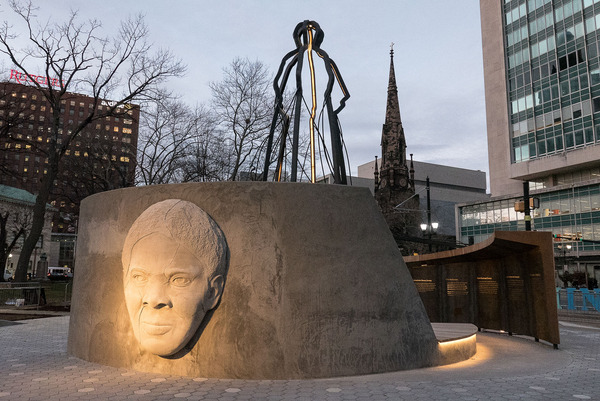
On March 9, the new Harriet Tubman Monument in Newark, NJ, designed by architect, artist, and United States Artists Fellow Nina Cooke John opened to the public. The two-story monument, Shadow of a Face, encourages visitors to connect with Harriet Tubman, her story, and her extraordinary legacy. Shadow of a Face is a Design for Freedom Pilot Project. The Grace Farms’ team worked with Cooke John on the transparent sourcing of materials for the monument, demonstrating her commitment to design and build with materials that are free of forced labor. Photos by Cesar Melgar, DreamPlay Media

Architect, artist, and United States Artists Fellow Nina Cooke John is working with Grace Farms on an on-site exhibit that will open in fall 2023. Photos by Cesar Melgar, DreamPlay Media
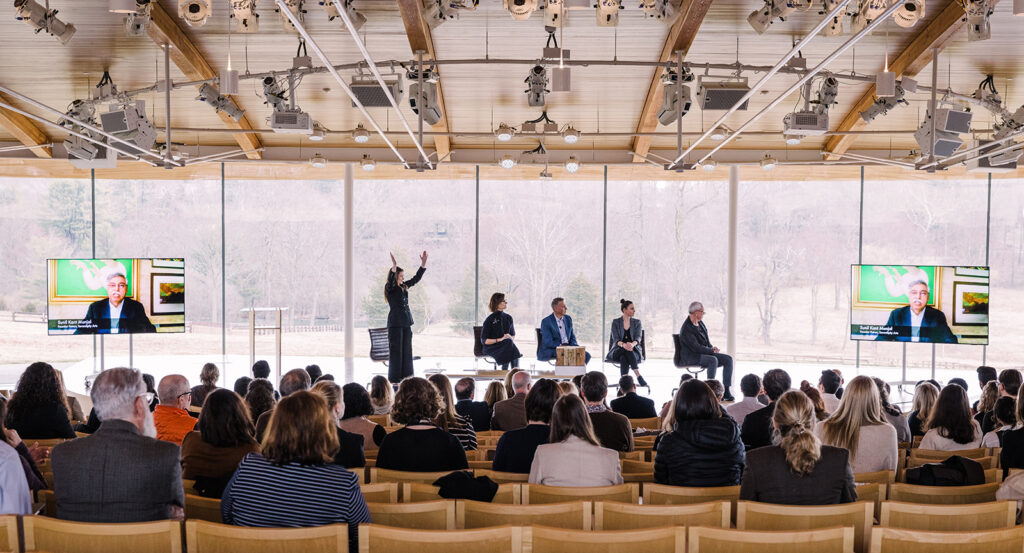
Chelsea Thatcher, Creative Director and Chief Advancement Officer (standing), announcing the Arts and Culture Center Pilot Project in New Delhi, India at the 2022 Design for Freedom Summit. More than 300 people attended last year’s Design for Freedom Summit. Photo by Jacek-Dolata
2023 Design for Freedom Summit Focus Topics & Schedule
Like last year, the Design for Freedom Summit will bring together leaders from the AEC industry, advocates, artists, scholars, government officials, media professionals, students, and others across sectors. The day-long event offers a unique opportunity to network, learn more about Design for Freedom, share best practices, and accelerate the movement. To register and for more information on speakers and travel.
Focus Topics:
- Design for Freedom Pilot Projects
- The Business Case
- Supply Chain Transparency
- Roundtable Deep Dives:
- Timber, Interiors, Circularity, Policy, and more
Enjoy breakfast and lunch, and cocktail hour, as well as an agenda designed to inspire collective action alongside leaders and partners in the Design for Freedom Movement.
AIA CES Approved 6 LU | HSW
March 30, 2023 Design for Freedom Summit Schedule
9 am – Registration, Breakfast & Exhibits
9:30 am – Music
- Marcus Miller, Grace Farms
- Florian Idenburg, SO-IL
- Nick Rosenboro, Architensions
10 am – Welcome Address
- Sharon Princer, Grace Farms
10:15 am – Accelerating the Movement | Pilot Projects
- Sharon Prince, Grace Farms
- Curtis Clay, U.S. Department of State, Bureau of Overseas Buildings Operations
- Jing Liu, SO-IL
- Kai-Uwe Bergmann, BIG
- Nina Cooke John, Studio Cooke John
- Pete Hamill, Turner Construction
11 am – The Business Case for Design for Freedom
- Richard Lui, MSNBC/NBC News
- Ana Hinojosa, US Customs & Border Protection and Oritain
- Debbie Propst, MillerKnoll
- Maha Khan, United Nations University
- Tateo Nakajima, Arup
11:45 am – Morning Break
- Adam Thatcher, Grace Farms Foods
12:15 pm – Supply Chain Transparency
- Nora Rizzo, Grace Farms
- Cristina Villegas, Pact
- Jim Vallette, Material Research L3C
- Paul J. Bradley, Lendlease Americas
- Dr. Shawn MacDonald, Verité
1 – 2:30 pm – Lunch & Architectural Tours
Toshihiro Oki, Grace Farms (formerly of SANAA)
2:30 pm – Roundtables
Building Materials and the Climate Report by Yale CEA & UNEP
- Anna Dyson, Yale Center for Ecosystems in Architecture
- Jim Vallette, Material Research L3C
- Dr. Mae ling Lokko, Willow Technologies and Yale School of Architecture
- Mohamed Aly Etman, Yale Center for Ecosystems + Architecture
Converting Textile Transparency to Interiors
- Ana Hinojosa, US Customs & Border Protection Advisor and Oritain
- Buxton Midyette, Supima Cotton
- Gabe Wing, MillerKnoll
- Hayes Slade, Slade Architecture
- Rachel Berkin, Tarkett
- Rebecca Best, Material Bank
Global Policy as a Driver
- Sharon Prince, Grace Farms
- Angel Dizon, Public Buildings (Great Lakes Region)
- Joanna Hall, SustainChain
- Dr. Lee Schwartz, Department of State, Office of the Geographer and Global Issues
- Luba Nikulina, IFM Investors and UK Task Force for Social Factors
- Peter Swartz, Altana AI
Material Circularity + Tech Innovation
- Brigid Abraham, Design for Freedom, Grace Farms
- Chris Sharples, SHoP
- Diana Kellogg, Diana Kellogg Architects
- Felix Heisel, Circular Construction Lab, Cornell University
- Florian Idenburg, SO-IL
Timber Studies
- Ben Dreith, Dezeen
- Dr. Jonathan Hermanson, University of Washington Center for Environmental Forensic Science
- Luciana Varkulja, uma architecture & design
- Rod Khattabi, Grace Farms
- Alina Reynolds, Grace Farms
Tools for Material Transparency
- Annie Bevan, Mindful Materials
- Barbra BatShalom, BuildingEase
- Evelyn Ritter, Toxnot
- James Slade, Slade Architecture
- Monica Becker, Cradle to Cradle
- Raphael Sperry, Arup
- Nora Rizzo, Grace Farms
4 pm – Inspiration & Action
- Featuring Platon, Platon Photo, founder of The People’s Portfolio, Peabody Award-winning photographer, storyteller, and human rights activist
- Jacqueline Corbelli, U.S. Coalition on Sustainabilty
- Kai-Uwe Bergmann, BIG
5 pm – Cocktail Hour
Together we can design a more humane future together!

Design for Freedom logo. Design by Grace Farms Foundation
For more information about the Summit or become a sponsor—contact us at [email protected].
Feature photo by Sahar-Coston-Hardy
About Grace Farms
Grace Farms is a center for culture and collaboration in New Canaan, Connecticut. We bring together people across sectors to explore nature, arts, justice, community, and faith at the SANAA-designed River building on 80 acres of publicly accessible, preserved natural landscape. Our humanitarian work to end modern slavery and foster more grace and peace in our local and global community includes leading the Design for Freedom movement to eliminate forced labor in building materials supply chain.
[1] Global Estimates of Modern Slavery: Forced Labour and Forced Marriage, International Labour Organization (ILO). September 2022.
[2] Statista and World Bank, 2018

